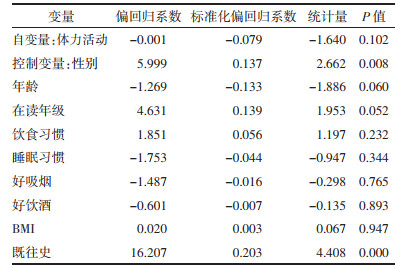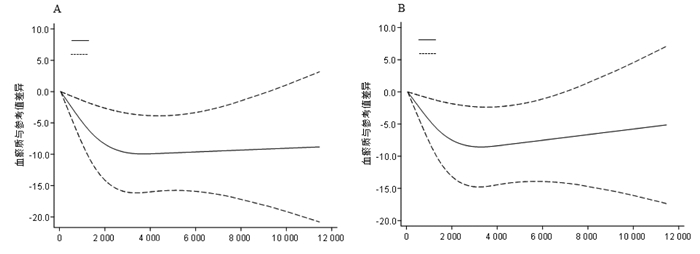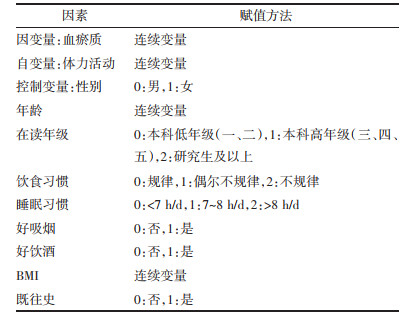文章信息
- 刘涵, 朱燕波, 米芸, 刘洋, 张会, 郑昆, 刘雯琼, 马方晖, 吴新瑞
- LIU Han, ZHU Yanbo, MI Yun, LIU Yang, ZHANG Hui, ZHENG Kun, LIU Wenqiong, MA Fanghui, WU Xinrui
- 大学生体力活动与血瘀质的剂量-反应关系-基于限制性立方样条模型
- Dose-response relationship between physical activity and blood stasis constitution of college students-based on restricted cubic spline model
- 天津中医药, 2021, 38(4): 447-452
- Tianjin Journal of Traditional Chinese Medicine, 2021, 38(4): 447-452
- http://dx.doi.org/10.11656/j.issn.1672-1519.2021.04.09
-
文章历史
- 收稿日期: 2020-11-23
中医体质学认为,体质是人体在生命过程中,在先天禀赋和后天获得的基础上,形成的具有形态结构、生理功能、心理状态等方面综合的、相对稳定的固有特质[1],血瘀质是中医9种体质中的一种,是指因血液运行不畅导致的以肤色晦暗、舌质紫黯等血瘀表现为主要特征的一种体质状态[2],约占全国总人口的8.1%[3],对人体的身心健康产生影响。有研究表明,血瘀质与冠心病、缺血性中风、痛经、多囊卵巢综合征、恶性肿瘤等多种疾病相关,影响着人们的身体健康[4-8]。此外,也有研究表明,血瘀质对心理健康产生影响,血瘀程度越严重,人们的心理健康状况越差,其是降低生命质量心理领域的主要因素之一[9]。
体力活动(PA)是指任何由骨骼肌收缩引起的导致能量消耗的身体运动,包括职业、交通、日常生活体力活动及闲暇时的体育锻炼[10]。当代大学生作为具有较高智力和较高追求的群体,在新的教育体制和就业形势下,比一般群体面临更多的机遇和挑战,对体力活动的要求也有所不同。相关研究表明,血瘀质的大学生体质健康标准最差,其不合格率为88.89%[11],究其原因,可能与大学生少动多坐的生活习惯相关[12]。此外,有研究表明,增加体力活动可以促进血液循环,改善血瘀质[13],但因血瘀质人群心血管系统功能较差,有学者认为血瘀质人群应避免高强度运动[14]。鉴于目前关于体力活动与血瘀质的关系认识尚不明晰,同时对于体力活动与血瘀质的量效关系研究缺乏,本研究引入限制性立方样条模型(RCS)拟合多元线性回归模型,讨论大学生体力活动与血瘀质的剂量-反应关系,为指导大学生科学合理的运动,提高健康水平提供依据。
1 对象与方法 1.1 研究对象2019年2-6月,采用立意抽样结合滚雪球抽样方法对北京中医药大学及其他高校(综合性大学及其他专业性大学)按1:1比例进行调查。
纳入标准:1)年满18周岁的在校本科生和研究生。2)有充分的时间独立完成调查问卷。3)签署知情同意书。
排除标准:因各种原因不能很好地完成调查问卷者。
1.2 研究内容背景情况:包括性别、年龄、所在年级、饮食习惯、睡眠习惯、吸烟情况、饮酒情况、体重指数(BMI)、既往病史等,由调查对象自行填报。
血瘀质状况:采用信效度良好的中医体质量表-41条目简短版(CCMQ-41)[15-17]进行调查,量表由平和质、气虚质、阳虚质、阴虚质、气郁质、血瘀质、痰湿质、湿热质、特禀质9个体质亚量表构成,共41个条目,各亚量表的转化分为0~100分,得分越高,体质倾向性越强。本研究选取血瘀质亚量表得分评估大学生的血瘀质程度,血瘀质亚量表的克朗巴赫α系数为0.718。
体力活动情况:采用国际体力活动问卷-短卷(IPAQ-SF)[18]评估研究对象的体力活动,该问卷由7个问题构成,包括高强度体力活动、中等强度体力活动、步行、静坐4部分。本研究总体力活动的计算仅考虑研究对象高、中强度体力活动和步行的能量代谢当量,由高、中等强度体力活动和每周步行时间(min)分别乘以8、4、3.3[代谢当量(METs)]获得[19]。
1.3 统计学方法使用EpiData 3.1录入数据,SPSS 22.0和Stata 15.0进行数据分析。计量资料以均数±标准差(x±s)表示,组间比较采用独立样本t检验;多组间比较采用单因素方差分析;定性资料用构成比(%)表示,组间比较采用χ2检验。采用Pearson相关及多元线性回归模型分析体力活动与血瘀质之间的关系;采用限制性立方样条[20]拟合多元线性回归模型分析体力活动与血瘀质的剂量-反应关系,体力活动与血瘀质以连续变量带入,体力活动由系统自动生成3个结点(403.2、1 386、4 249.8),并以体力活动每周49.5 MET -min为参考值,绘制限制性立方样条图。所有检验采取双侧检验,P < 0.05为差异具有统计学意义。
2 结果本研究发放问卷506份(其中北京中医药大学学生269例),回收500例有效数据,剔除48例无任何运动或者分析变量缺失样本,最终对452例样本进行分析。
2.1 基本情况452例调查对象中,男131例,占29.0%;女321例,占71.0%。年龄在18~30岁之间,平均年龄为(21.04±2.092)岁。本科低年级(大一、二)116例,占25.7%;本科高年级282例(大三、四、五),占62.4%;研究生54例,占11.9%。饮食习惯方面,规律饮食者156例,占34.5%;偶尔不规律者258例,占57.1%;不规律者38例,占8.4%。睡眠情况方面,<7 h/d睡眠者76例,占16.8%;7~8 h/d睡眠者336例,占74.3%;>8 h/d睡眠者40例,占8.8%。吸烟情况方面,好吸烟23例,占5.1%;不好吸烟429例,占94.9%。饮酒情况方面,好饮酒27例,占6.0%;不好饮酒425例,占94.0%。在既往病史中,有既往病史30例,占6.6%;没有既往病史423例,占93.4%。BMI均值为(20.57±3.06)kg/m2。血瘀质平均得分>30分有241例(53%),≤30分有211例(47%),平均得分为(35.28±19.91)分。体力活动平均值为每周(2 020.39±1 852.39)MET-min。
2.2 不同特征人群血瘀质得分不同特征人群血瘀质得分结果显示,年龄(r=0.01,P=0.888)、BMI(r= -0.04,P=0.458)与血瘀质之间无显著相关关系。不同性别、在读年级、既往病史的大学生血瘀质得分差异有统计学意义(P < 0.01)。详细结果见表 1。
 |
Pearson相关分析显示,血瘀质得分与体力活动呈负相关(r=-0.109,P < 0.05)。以血瘀质得分为因变量,体力活动为自变量,以性别、年龄、在读年级、饮食习惯、睡眠习惯、好吸烟、好饮酒、BMI、既往病史作为控制变量进行多元线性回归分析,结果显示,体力活动与血瘀质之间的关系无统计学意义(P>0.05),尚无法判断体力活动与血瘀质之间存在线性关系。见表 2、3。
 |
采用限制性立方样条拟合线性回归模型分析体力活动与血瘀质之间的关系,结果显示,体力活动与血瘀质呈近似的“L”型曲线(P < 0.01),血瘀质得分最低点的体力活动约为每周3 000 MET-min,说明体力活动在小于每周3 000 MET-min的情况下,随着体力活动的增加,血瘀质得分降低;但当体力活动超过每周3 000 MET-min,体力活动对血瘀质得分的继续降低作用有限。进一步控制性别、年龄、在读年级、饮食习惯、睡眠习惯、好吸烟、好饮酒、BMI、既往病史等混杂因素后,体力活动与血瘀质之间仍呈近似“L”型的曲线(P < 0.01)。见图 1。

|
| 注:A.未调整混杂因素;B.调整了性别、年龄、在读年级、饮食习惯、睡眠习惯、好吸烟、好饮酒、BMI、既往病史。 图 1 体力活动与血瘀质的剂量-反应关系图 Fig. 1 Dose-response relationship between physical activity and blood stasis constitution |
大学生作为一类受特别关注的群体,其健康状况一直被社会广泛关注,多静少动的生活方式普遍存在于大学生中,多静少动易使血流速度减缓,长久或形成血瘀质,而体力活动是改善血瘀质的有效方式之一,通过探究大学生体力活动与血瘀质的剂量-反应关系,可以为改善血瘀质,促进健康,预防血瘀质相关疾病的发生提供科学依据。
本研究分析了大学生体力活动与血瘀质的剂量-反应关系,结果表明,体力活动与血瘀质存在近似“L”型的曲线,血瘀质得分最低点的体力活动约为每周3 000 MET-min;对于血瘀质人群来说,随着体力活动的增加,血瘀质得分降低,但当体力活动超过每周3 000 MET-min,其对血瘀质得分的继续降低作用有限。
中医体质学认为血瘀质人群一般体内存在血液运行不畅的潜在倾向,或有瘀血内阻的病理基础,具体表现为肤色晦暗,色素沉着,易出现瘀斑,口唇黯淡或有瘀点,舌质紫黯,舌下脉络紫黯或有瘀血,脉涩等症状[2]。运动是改善血瘀质的有效方式[21]。本研究选用研究对象总的能量代谢当量衡量受试者的体力活动情况,其包括受试者在过去7 d内高、中等强度体力活动及日常步行体力活动。此次研究发现,体力活动与血瘀质呈负相关(r=-0.109,P < 0.05),进行一定的体力活动,可能会降低血瘀质得分,与既往研究一致[17, 22]。同时,调整性别、年龄、在读年级、饮食习惯、睡眠习惯、好吸烟、好饮酒、BMI、既往病史的多元线性回归表明,体力活动与血瘀质之间存在非线性关系(线性检验:β=-0.079,t=-1.640,P=0.102)。
《道德经》和《吕氏春秋》中均记载进行适当的体力活动可以改善血瘀的情况。现代研究也表明体力活动可以改善血瘀质[23-24]。那么是否可以推测体力活动与血瘀质之间存在非线性的剂量-反应关系,目前缺乏相关研究。
本次研究调整了性别、年龄、在读年级、饮食习惯、睡眠习惯、好吸烟、好饮酒、BMI、既往病史的限制性立方样条拟合多元线性回归模型分析体力活动与血瘀质的关系,结果表明,体力活动与血瘀质之间存在非线性剂量-反应关系(非线性检验:P non-linearity < 0.01)。从剂量-反应图中可以看出,体力活动与血瘀质存在近似“L”型的曲线。对于血瘀质来说,当体力活动小于每周3 000 MET-min时,增加体力活动可使血瘀质得分持续降低。
中医基础理论认为“气为血之帅,血为气之母”,当个体进行一定量的体力活动时,人体气机随之调动,推动血液运行,改善血瘀体质;运动不足,血液运动缓慢,气机不畅,易形成血瘀。如李明霞等[25]研究发现,缺乏运动易形成血瘀质,而长期规律的运动锻炼可以改善女性血瘀质状况。郎振敏等[26]研究表现,有规律的运动锻炼能有效改善心血管系统。究其原因,《素问·宣明五气论》认为“劳役辛勤太过,渐耗真气”,当个体进行较多的体力活动,超过身体机能的承受范围,易损耗人体之气,进而无力推动血液运行,使血液流速减缓。
运动具有简单、便利、高效等特点,可以促进气血通畅、五脏调和、阴阳平衡,是改善大学生血瘀质的有效方式之一。本次研究调查发现进行约每周3 000 MET-min的体力活动(即每天进行大约54 min的高强度运动,或107 min的中等强度运动,或130 min步行),能达到改善血瘀质的最佳效果,其体力活动量基本符合美国医学院对在校大学生体力活动推荐量的标准(美国医学院对在校大学生体力活动推荐量为每天60 min以上的中高强度体力活动[27])。因体质具有相对稳定性,通过体力活动改善大学生血瘀质是一个长期的过程,因此,健康管理师或学校体育指导师为大学生制定运动处方,在考虑将个体的体力活动合理的控制在每周3 000 MET-min下,可以将多种运动方式相结合,增加运动的娱乐性,以调动大学生对体育锻炼的热情和积极性,使他们养成规律的运动锻炼习惯,改善血瘀质状况。此外,因血瘀质个体心血管功能较差,要根据自身运动反应及时调整运动方案。
4 结论既往研究大多指出不同体质类型人群需要适度的运动,但对适度的概念缺乏量化标准,本次研究发现,血瘀质与体力活动之间存在近似“L”型的曲线,适当增加体力活动,可以改善血瘀质,这为进一步研究包括血瘀质在内的其他体质类型人群的合理运动量提供借鉴思路。
本研究也存在一定局限性。首先,本研究使用的体力活动指标为研究对象总体力活动的能量代谢当量,未分析不同强度体力活动与血瘀质的关系。其次,本研究结果的稳健性需通过增加样本量进一步验证。同时,此次结果为横断面研究,无法推断运动量与血瘀质的因果关系。
| [1] |
王琦. 中医体质学[M]. 北京: 人民卫生出版社, 2008: 59-90. WANG Q. Constitution of traditional Chinese medicine[M]. Beijing: People's Medical Publishing House, 2008: 59-90. |
| [2] |
王琦. 9种基本中医体质类型的分类及其诊断表述依据[J]. 北京中医药大学学报, 2005, 28(4): 1-8. WANG Q. Classification and diagnosis basis of nine basic constitutions in Chinese medicine[J]. Journal of Beijing University of Traditional Chinese Medicine, 2005, 28(4): 1-8. |
| [3] |
王琦, 朱燕波. 中国一般人群中医体质流行病学调查-基于全国9省市21948例流行病学调查数据[J]. 中华中医药杂志, 2009, 24(1): 7-12. WANG Q, ZHU Y B. Epidemiological investigation of constitutional types of Chinese medicine in general population: base on 21948 epidemiological investigation data of nine provinces in China[J]. China Journal of Traditional Chinese Medicine and Pharmacy, 2009, 24(1): 7-12. |
| [4] |
黎立明, 李思宁, 魏丹蕾. 岭南地区冠心病心绞痛患者中医体质分布规律[J]. 中医杂志, 2012, 53(15): 1305-1307. LI L M, LI S N, WEI D L. The constitution distribution of angina pectoris patients in Lingnanarea[J]. Journal of Traditional Chinese Medicine, 2012, 53(15): 1305-1307. |
| [5] |
冯鹏硕. 缺血性中风血瘀质患者与缺血性中风危险因素的相关性研究[D]. 长春: 长春中医药大学, 2019. FENG P S. Study on the correlation between blood stasis of ischemic stroke and risk factors for ischemic stroke[D]. Changchun: Changchun University of Chinese Medicine, 2019. |
| [6] |
黄蓉, 廖星, 罗辉, 等. 原发性痛经大学生中医体质类型研究的Meta分析[J]. 安徽中医药大学学报, 2017, 36(4): 34-38. HUANG R, LIAO X, LUO H, et al. Association between primary dysmenorrhea and traditional Chinese medicine constitution type in female college students: a Meta-analysis[J]. Journal of Anhui University of Chinese Medicine, 2017, 36(4): 34-38. DOI:10.3969/j.issn.2095-7246.2017.04.012 |
| [7] |
潘兆兰, 欧阳莎, 刘英. 多囊卵巢综合征患者中医体质分布规律初探[J]. 中医药通报, 2016, 15(4): 52-53, 55. PAN Z L, OUYANG S, LIU Y. Distribution of TCM constitution in patients with polycystic ovary syndrome[J]. Traditional Chinese Medicine Journal, 2016, 15(4): 52-53, 55. |
| [8] |
纪立秋. 中医药对90例恶性肿瘤患者中医体质影响研究[J]. 亚太传统医药, 2016, 12(1): 96-98. JI L Q. Influence of traditional Chinese medicine on constitution of 90 patients with malignant tumor[J]. Asia-Pacific Traditional Medicine, 2016, 12(1): 96-98. |
| [9] |
王琦, 朱燕波, 吴承玉, 等. 中医体质与健康相关生命质量的相关性[J]. 中国组织工程研究与临床康复, 2007, 49(11): 9946-9950. WANG Q, ZHU Y B, WU C Y, et al. Correlation between constitution in Chinese medicine and health-related quality of life[J]. Chinese Journal of Tissue Engineering Research, 2007, 49(11): 9946-9950. |
| [10] |
谌晓安, 王人卫, 白晋湘. 体力活动、体适能与健康促进研究进展[J]. 中国运动医学杂志, 2012, 31(4): 363-372. SHEN X A, WANG R W, BAI J X. Research progress of physical activity, physical fitness and health promotion[J]. Chinese Journal of Sports Medicine, 2012, 31(4): 363-372. DOI:10.3969/j.issn.1000-6710.2012.04.016 |
| [11] |
吴志坤, 张彩, 徐仰才. 中医体质测试与现行大学生体质健康测试成绩的相关性分析[J]. 北京中医药大学学报, 2014, 37(9): 598-601. WU Z K, ZHANG C, XU Y C. Correlation between results of TCM constitutional test and present physical fitness test in college students[J]. Journal of Beijing University of Chinese Medicine, 2014, 37(9): 598-601. DOI:10.3969/j.issn.1006-2157.2014.09.006 |
| [12] |
林瑜. 我国体力活动研究现状评述[J]. 鄂州大学学报, 2019, 26(1): 103-104. LIN Y. A review on the research status of physical activity in China[J]. Journal of Ezhou University, 2019, 26(1): 103-104. |
| [13] |
李明霞. 女性血瘀体质特征及影响因素研究[D]. 济南: 山东中医药大学, 2014. LI M X. Study on physical characteristics and influencing factors of female blood stasis[D]. Jinan: Shandong University of Traditional Chinese Medicine, 2014. |
| [14] |
陈道睿, 潘华山, 张珏. 中医体质与运动损伤的关系探讨[J]. 亚太传统医药, 2014, 10(20): 28-29. CHEN D R, PAN H S, ZHANG J. Discussion on the relationship between TCM Constitution and sports injury[J]. Asia-Pacific Traditional Medicine, 2014, 10(20): 28-29. |
| [15] |
朱燕波, 虞晓含, 王琦, 等. 简短版中医体质量表的初步设置与考评[J]. 中国全科医学, 2017, 20(7): 879-885. ZHU Y B, YU X H, WANG Q, et al. Preliminary development and evaluation of the short-version constitution in Chinese medicine questionnaire[J]. Chinese General Practice, 2017, 20(7): 879-885. DOI:10.3969/j.issn.1007-9572.2017.07.023 |
| [16] |
朱燕波, 王琦, 虞晓含, 等. 中医体质量表-41条目简短版的结构效度和反应度评价[J]. 中国全科医学, 2017, 20(26): 3282-3286. ZHU Y B, WANG Q, YU X H, et al. Construct validity and responsiveness of the 41-item short version of constitution in Chinese medicine questionnaire[J]. Chinese General Practice, 2017, 20(26): 3282-3286. |
| [17] |
朱燕波, 史会梅, 虞晓含. 不同条目版本的中医体质量表在健康人群中应用的性能比较[J]. 中国全科医学, 2019, 22(35): 4381-4387. ZHU Y B, SHI H M, YU X H. Comparison of the performance of three versions of constitution of Chinese medicine questionnaire for healthy populations[J]. Chinese General Practice, 2019, 22(35): 4381-4387. |
| [18] |
屈宁宁, 李可基. 国际体力活动问卷中文版的信度和效度研究[J]. 中华流行病学杂志, 2004, 25(3): 87-90. QU N N, LI K J. Reliability and validity of Chinese version of international physical activity questionnaire[J]. China Journal of Traditional Chinese Medicine and Pharmacy, 2004, 25(3): 87-90. |
| [19] |
AINSWORTH B E, HASKELL W L, WHITT M C, et al. Compendium of physician activities: an update of activity codes and MET intensities[J]. Medicine and Science in Sports and Exercise, 2000, 32(supplement): S498-504. |
| [20] |
DESQUILBET L, MARIOTTI F. Dose-response analyses using restricted cubic spline functions in public health research[J]. Statistics in Medicine, 2010, 29(9): 1037-1057. |
| [21] |
刘阳. 中医瘀血体质的养生研究[D]. 长沙: 湖南中医药大学, 2018. LIU Y. Study on health maintenance of TCM blood stasis constitution[D]. Changsha: Hunan University of Chinese Medicine, 2018. |
| [22] |
黄姚. 大学生身体活动与中医体质关系研究[D]. 南京: 南京师范大学, 2019. HUANG Y. Study on the relationship between college students' physical activity and constitution of traditional Chinese medicine[D]. Nanjing: Nanjing Normal University, 2019. |
| [23] |
石劢, 刘兆兰, 许美艳, 等. 北京城区居家老年人生活习惯与中医体质类型的相关性[J]. 中国中西医结合杂志, 2016, 36(5): 564-569. SHI M, LIU Z L, XU M Y, et al. Relationship between life habits and constitution types of Chinese medicine in the senile living at home in Beijing downtown[J]. Chinese Journal of integrated traditional Chinese and Western medicine, 2016, 36(5): 564-569. |
| [24] |
史穆然. 久坐、运动与中医体质的关系研究[D]. 北京: 北京中医药大学, 2019. SHI M R. Study on the relationship between sedentary, exercise and constitution of traditional Chinese medicine[D]. Beijing: Beijing University of Chinese Medicine, 2019. |
| [25] |
李明霞, 韩继振, 欧阳兵. 女性血瘀体质的影响因素分析[J]. 中医杂志, 2015, 56(15): 1290-1293. LI M X, HAN J Z, OUYANG B. Analysis on influencing factors of Blood stasis constitution in females[J]. Journal of Traditional Chinese Medicine, 2015, 56(15): 1290-1293. |
| [26] |
郎振敏, 闫薇, 闫晗. 不同强度运动对心血管病病人康复效果的Meta分析[J]. 护理研究, 2018, 32(12): 1896-1900. LANG Z M, YAN W, YAN H. Meta-analysis of rehabilitation effect of different intensity exercises for patients with cardiovascular disease[J]. Chinese Nursing Research, 2018, 32(12): 1896-1900. |
| [27] |
Institute of Medicine. Dietary reference intakes: energy, carbohydrate, fiber, fat, fatty acids, cholesterol, protein, and amino acids[M]. Washington DC: National AcademyPress, 2002.
|
 2021, Vol. 38
2021, Vol. 38





